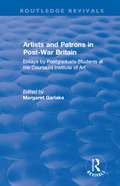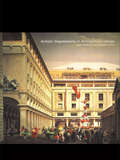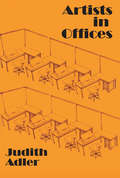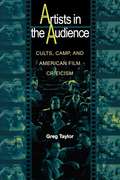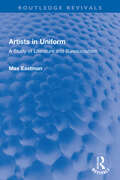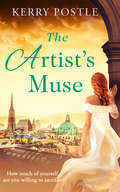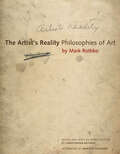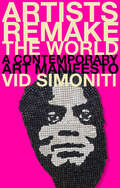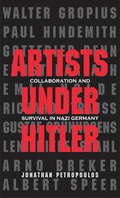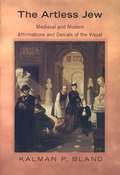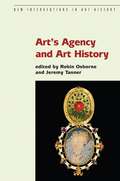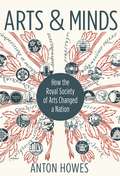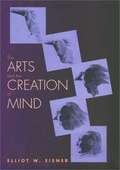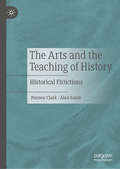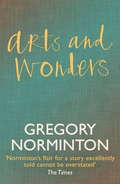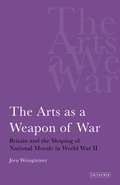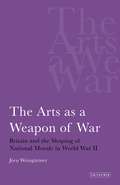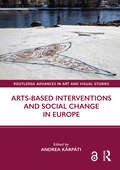- Table View
- List View
Artists and Patrons in Post-war Britain
by Courtauld Institute of ArtThis title was first published in 2001. An examination of art and patronage in Britain during the post-war years. It consists of five case studies, initially written as MA theses, that closely investigate aspects of the mechanisms of patronage outside the state institutions, while indicating structural links within it. The writers have sought to elucidate the relationship between patronage, the production of art and its dissemination. Without seeking to provide an inclusive account of patronage or art production in the early post-war years, their disparate and highly selective papers set up models for the structure of patronage under specific historical conditions. They assume an understanding that works of art are embedded in their social contexts, are products of the conditions under which they were produced, and that these contexts and conditions are complex, fluid and imbricated in one another.
Artists' Impressions in Architectural Design: Null
by Bob Giddings Margaret HorneArtists' Impressions in Architectural Design analyses the ways in which architects have presented their designs for clients and the public, both historically and contemporarily. It spans a period from the fifteenth to the twenty-first century.Architects have become familiar with change. The passage of time has brought with it new and revived styles of architecture, as well as innovative tools and techniques for their representation. The result is that while some methods show a view of the architect's concept for a building, others offer an almost real experience of the intended architecture. This book provides a rare and valuable study in which the exciting technological developments of today are placed in context with the rich heritage of the past. It offers an opportunity to learn how architects have chosen to represent their ideas. The authors dare to glimpse into the future and hopefully offer some reassurance for tomorrow.
Artists' Impressions in Architectural Design
by Bob Giddings Margaret HorneArtists' Impressions in Architectural Design analyses the ways in which architects have presented their designs for clients and the public, both historically and contemporarily. It spans a period from the fifteenth to the twenty-first century.Architects have become familiar with change. The passage of time has brought with it new and revived styles of architecture, as well as innovative tools and techniques for their representation. The result is that while some methods show a view of the architect's concept for a building, others offer an almost real experience of the intended architecture. This book provides a rare and valuable study in which the exciting technological developments of today are placed in context with the rich heritage of the past. It offers an opportunity to learn how architects have chosen to represent their ideas. The authors dare to glimpse into the future and hopefully offer some reassurance for tomorrow.
Artists in Offices: An Ethnography of an Academic Art Scene
by Judith E. AdlerUniversities have become important sources of patronage and professional artistic preparation. With the growing academization of art instruction, young artists are increasingly socialized in bureaucratic settings, and mature artists find themselves working as organizational employees in an academic setting. As these artists lose the social marginality and independence associated with an earlier, more individual aesthetic production, much cultural mythology about work in the arts becomes obsolete.This classic ethnography, based on fieldwork and interviews carried out at the California Institute of the Arts in the 1980s, analyzes the day-to-day life of an organization devoted to work in the arts. It charts the rise and demise of a particular academic art "scene," an occupational utopian community that recruited its members by promising them an ideal work setting.Now available in paperback, it offers insight into the worlds of art and education, and how they interact in particular settings. The nature of career experience in the arts, in particular its temporal structure, makes these occupations particularly receptive to utopian thought. The occupational utopia that served as a recruitment myth for the particular organization under scrutiny is examined for what it reveals about the otherwise unexpressed impulses of the work world.
Artists in Offices: An Ethnography of an Academic Art Scene
by Judith E. AdlerUniversities have become important sources of patronage and professional artistic preparation. With the growing academization of art instruction, young artists are increasingly socialized in bureaucratic settings, and mature artists find themselves working as organizational employees in an academic setting. As these artists lose the social marginality and independence associated with an earlier, more individual aesthetic production, much cultural mythology about work in the arts becomes obsolete.This classic ethnography, based on fieldwork and interviews carried out at the California Institute of the Arts in the 1980s, analyzes the day-to-day life of an organization devoted to work in the arts. It charts the rise and demise of a particular academic art "scene," an occupational utopian community that recruited its members by promising them an ideal work setting.Now available in paperback, it offers insight into the worlds of art and education, and how they interact in particular settings. The nature of career experience in the arts, in particular its temporal structure, makes these occupations particularly receptive to utopian thought. The occupational utopia that served as a recruitment myth for the particular organization under scrutiny is examined for what it reveals about the otherwise unexpressed impulses of the work world.
Artists in the Audience: Cults, Camp, and American Film Criticism (PDF)
by Greg TaylorGone with the Wind an inspiration for the American avant-garde? Mickey Mouse a crucial source for the development of cutting-edge intellectual and aesthetic ideas? As Greg Taylor shows in this witty and provocative book, the idea is not so far-fetched. One of the first-ever studies of American film criticism, Artists in the Audience shows that film critics, beginning in the 1940s, turned to the movies as raw material to be molded into a more radical modernism than that offered by any other contemporary artists or thinkers. In doing so, they offered readers a vanguard alternative that reshaped postwar American culture: nonaesthetic mass culture reconceived and refashioned into rich, personally relevant art by the attuned, creative spectator.
Artists in the Audience: Cults, Camp, and American Film Criticism (PDF)
by Greg TaylorGone with the Wind an inspiration for the American avant-garde? Mickey Mouse a crucial source for the development of cutting-edge intellectual and aesthetic ideas? As Greg Taylor shows in this witty and provocative book, the idea is not so far-fetched. One of the first-ever studies of American film criticism, Artists in the Audience shows that film critics, beginning in the 1940s, turned to the movies as raw material to be molded into a more radical modernism than that offered by any other contemporary artists or thinkers. In doing so, they offered readers a vanguard alternative that reshaped postwar American culture: nonaesthetic mass culture reconceived and refashioned into rich, personally relevant art by the attuned, creative spectator.
Artists in Uniform: A Study of Literature and Bureaucratism (Routledge Revivals)
by Max EastmanFirst published in 1934, Artists in Uniform confronts what the author describes as ‘two of the worst features of the Soviet experiment’ following Lenin’s death – bigotry and bureaucratism – and shows how they have functioned in the sphere of arts and letters. It is divided into three parts: The Artist’s International; A Literary Inquisition; and Art and the Marxian Philosophy.
Artists in Uniform: A Study of Literature and Bureaucratism (Routledge Revivals)
by Max EastmanFirst published in 1934, Artists in Uniform confronts what the author describes as ‘two of the worst features of the Soviet experiment’ following Lenin’s death – bigotry and bureaucratism – and shows how they have functioned in the sphere of arts and letters. It is divided into three parts: The Artist’s International; A Literary Inquisition; and Art and the Marxian Philosophy.
The Artist’s Muse
by Kerry Postle‘The author tells an evocative story that is both illuminating and engrossing at the same time.’ Allie Burns, author of The Lido Girls ‘Lush and evocative.’ Rosemary Smith ‘The writing elevates this beyond many historical novels.’ Joseph Morgan Vienna 1907
Artists of the Possible: Governing Networks and American Policy Change since 1945 (Studies in Postwar American Political Development)
by Matt GrossmannDo policymakers heed the voices of the American public or only the lobbyists in Washington? Why do they take action on health reform, but not gun control? Why does policymaking usually move slowly, and sometimes not at all? Artists of the Possible takes on these questions, analyzing sixty years of domestic policy history to provide a new understanding of what drives policymaking in all three branches of government. The results are surprising: public policy does not address the public's largest concerns. The amount of policy-and its liberal or conservative direction-emerges instead from coalition building and compromises among political elites. Elections, public opinion, and media coverage have little impact, no matter the issue area. Even changes in Washington's partisan balance and ideological divides fail to reliably produce shifts in policy direction. This data-rich, exhaustively researched work overturns our most basic assumptions about how policy is made, challenging the notion that our government is of, by, and for the people.
Artists of the Possible: Governing Networks and American Policy Change since 1945 (Studies in Postwar American Political Development)
by Matt GrossmannDo policymakers heed the voices of the American public or only the lobbyists in Washington? Why do they take action on health reform, but not gun control? Why does policymaking usually move slowly, and sometimes not at all? Artists of the Possible takes on these questions, analyzing sixty years of domestic policy history to provide a new understanding of what drives policymaking in all three branches of government. The results are surprising: public policy does not address the public's largest concerns. The amount of policy-and its liberal or conservative direction-emerges instead from coalition building and compromises among political elites. Elections, public opinion, and media coverage have little impact, no matter the issue area. Even changes in Washington's partisan balance and ideological divides fail to reliably produce shifts in policy direction. This data-rich, exhaustively researched work overturns our most basic assumptions about how policy is made, challenging the notion that our government is of, by, and for the people.
The Artist's Reality: Philosophies of Art
by Mark RothkoMark Rothko’s classic book on artistic practice, ideals, and philosophy, now with an expanded introduction and an afterword by Makoto Fujimura Stored in a New York City warehouse for many years after the artist’s death, this extraordinary manuscript by Mark Rothko (1903–1970) was published to great acclaim in 2004. Probably written in 1940 or 1941, it contains Rothko’s ideas on the modern art world, art history, myth, beauty, the challenges of being an artist in society, the true nature of “American art,” and much more. In his introduction, illustrated with examples of Rothko’s work and pages from the manuscript, the artist’s son, Christopher Rothko, describes the discovery of the manuscript and the fascinating process of its initial publication. This edition includes discussion of Rothko’s “Scribble Book” (1932), his notes on teaching art to children, which has received renewed scholarly attention in recent years and provides clues to the genesis of Rothko’s thinking on pedagogy. In an afterword written for this edition, artist and author Makoto Fujimura reflects on how Rothko’s writings offer a “lifeboat” for “art world refugees” and a model for upholding artistic ideals. He considers the transcendent capacity of Rothko’s paintings to express pure ideas and the significance of the decade-long gap between The Artist’s Reality and Rothko’s mature paintings, during which the horrors of the Holocaust and the atomic bomb were unleashed upon the world.
Artists Remake the World: A Contemporary Art Manifesto
by Vid SimonitiAn original and provocative exploration of the relationship between contemporary art, politics, and activism Artists Remake the World introduces readers to the political ambitions of contemporary art in the early twenty-first century and puts forward a new, wide-ranging account of art’s political potential. Surveying such innovations as evidence-driven art, socially engaged art, and ecological art, the book explores how artists have attempted to offer bold solutions to the world’s problems. Vid Simoniti offers original perspectives on contemporary art and its capacity as a force for political and social change. At its best, he argues, contemporary art allows us to imagine utopias and presents us with hard truths, which mainstream political discourse cannot yet articulate. Covering subjects such as climate change, social justice, and global inequality, Simoniti introduces the reader to a host of visionary contemporary artists from across the globe, including Ai Weiwei, Olafur Eliasson, Wangechi Mutu, Naomi Rincón Gallardo, and Hito Steyerl. Offering a philosophy of contemporary art as an experimental branch of politics, the book equips the reader with a new critical apparatus for thinking about political art today.
Artists Under Hitler: Collaboration and Survival in Nazi Germany
by Jonathan Petropoulos“What are we to make of those cultural figures, many with significant international reputations, who tried to find accommodation with the Nazi regime?” Jonathan Petropoulos asks in this exploration of some of the most acute moral questions of the Third Reich. In his nuanced analysis of prominent German artists, architects, composers, film directors, painters, and writers who rejected exile, choosing instead to stay during Germany’s darkest period, Petropoulos shows how individuals variously dealt with the regime’s public opposition to modern art. His findings explode the myth that all modern artists were anti-Nazi and all Nazis anti-modernist. Artists Under Hitler closely examines cases of artists who failed in their attempts to find accommodation with the Nazi regime (Walter Gropius, Paul Hindemith, Gottfried Benn, Ernst Barlach, Emil Nolde) as well as others whose desire for official acceptance was realized (Richard Strauss, Gustaf Gründgens, Leni Riefenstahl, Arno Breker, Albert Speer). Collectively these ten figures illuminate the complex cultural history of Nazi Germany, while individually they provide haunting portraits of people facing excruciating choices and grave moral questions.
The Artless Jew: Medieval and Modern Affirmations and Denials of the Visual
by Kalman P. BlandConventional wisdom holds that Judaism is indifferent or even suspiciously hostile to the visual arts due to the Second Commandment's prohibition on creating "graven images," the dictates of monotheism, and historical happenstance. This intellectual history of medieval and modern Jewish attitudes toward art and representation overturns the modern assumption of Jewish iconophobia that denies to Jewish culture a visual dimension. Kalman Bland synthesizes evidence from medieval Jewish philosophy, mysticism, poetry, biblical commentaries, travelogues, and law, concluding that premodern Jewish intellectuals held a positive, liberal understanding of the Second Commandment and did, in fact, articulate a certain Jewish aesthetic. He draws on this insight to consider modern ideas of Jewish art, revealing how they are inextricably linked to diverse notions about modern Jewish identity that are themselves entwined with arguments over Zionism, integration, and anti-Semitism. Through its use of the past to illuminate the present and its analysis of how the present informs our readings of the past, this book establishes a new assessment of Jewish aesthetic theory rooted in historical analysis. Authoritative and original in its identification of authentic Jewish traditions of painting, sculpture, and architecture, this volume will ripple the waters of several disciplines, including Jewish studies, art history, medieval and modern history, and philosophy.
Arto Salomaa: A Thematic Biography
by Jukka PaakkiThis book outlines the scientific career of Arto Salomaa, a pioneer in theoretical computer science and mathematics. The author first interviewed the subject and his family and collaborators, and he then researched this fascinating biography of an intellectual who was key in the development of these fields.Early chapters progress chronologically from Academician Salomaa's origins, childhood, and education to his professional successes in science, teaching, and publishing. His most impactful direct research efforts have been in the areas of automata and formal languages. Beyond that he has influenced many more scientists and professionals through collaborations, teaching, and books on topics such as biocomputing and cryptography. The author offers insights into Finnish history, culture, and academia, while historians of computer science will appreciate the vignettes describing some of the people who have shaped the field from the 1950s to today. The author and his subject return throughout to underlying themes such as the importance of family and the value of longstanding collegial relationships, while the work and achievements are leavened with humor and references to interests such as music, sport, and the sauna.
Art's Agency and Art History (New Interventions in Art History)
by Robin Osborne Jeremy TannerArt's Agency and Art History re-articulates the relationship of the anthropology of art to key methodological and theoretical approaches in art history, sociology, and linguistics. Explores important concepts and perspectives in the anthropology of art Includes nine groundbreaking case studies by an internationally renowned group of art historians and art theorists Covers a wide range of periods, including Bronze-Age China, Classical Greece, Rome, and Mayan, as well as the modern Western world Features an introductory essay by leading experts, which helps clarify issues in the field Includes numerous illustrations
Arts and Minds: How the Royal Society of Arts Changed a Nation
by Anton HowesA major new history of the extraordinary society that has touched all aspects of British lifeFrom its beginnings in a coffee house in the mid-eighteenth century, the Royal Society for the Encouragement of Arts, Manufactures and Commerce has tried to improve British life in every way imaginable. It has sought to influence how Britons work, how they are educated, the music they listen to, the food they eat, the items in their homes, and even how they remember their own history. Arts and Minds is the remarkable story of an institution unlike any other—a society for the improvement of everything and anything.Drawing on exclusive access to a wealth of rare papers and artefacts from the Society's own archives, Anton Howes shows how this vibrant and singularly ambitious organisation has evolved and adapted, constantly having to reinvent itself to keep in step with changing times. The Society has served as a platform for Victorian utilitarian reformers, purchased and restored an entire village, encouraged the planting of more than sixty million trees, and sought technological alternatives to child labour. But this is more than just a story about unusual public initiatives. It is an engaging and authoritative history of almost three centuries of social reform and competing visions of a better world—the Society's members have been drawn from across the political spectrum, including Adam Smith, Edmund Burke, and Karl Marx.Informative and entertaining, Arts and Minds reveals how a society of public-spirited individuals tried to make their country a better place, and draws vital lessons from their triumphs and failures for all would-be reformers today.
The Arts And The Creation Of Mind (PDF)
by Elliot W. EisnerAlthough the arts are often thought to be closer to the rim of education than to its core, they are, surprisingly, critically important means for developing complex and subtle aspects of the mind, argues Elliot Eisner in this discussion. In it he describes how various forms of thinking are evoked, developed, and refined through the arts. These forms of thinking, Eisner argues, are more helpful in dealing with the ambiguities and uncertainties of daily life than are the formally structured curricula that are employed today in schools. Offering an array of examples, Eisner describes different approaches to the teaching of the arts and the virtues each possesses when well taught. He discusses especially nettlesome issues pertaining to the evaluation of performance in the arts. Perhaps most importantly, Eisner seeks to provide a fresh and admittedly iconoclastic perspective on what the arts can contribute to education, namely a new vision of both its aims and its means. This new perspective, Eisner argues, is especially important today, a time at which mechanistic forms of technical rationality often dominate our thinking about the conduct and assessment of education.
The Arts and the Teaching of History: Historical F(r)ictions
by Penney Clark Alan SearsThis book closely examines the pedagogical possibilities of integrating the arts into history curriculum at the secondary and post-secondary levels. Students encounter expressions of history every day in the form of fiction, paintings, and commemorative art, as well as other art forms. Research demonstrates it is often these more informal encounters with history that define students’ knowledge and understandings rather than the official accounts present in school curricula. This volume will provide educators with tools to bring together these parallel tracks of history education to help enrich students’ understandings and as a mechanism for students to present their own emerging historical perspectives.
Arts and Wonders
by Gregory NormintonARTS AND WONDERS spans a glorious canvas, peopled by werewolves, thieves, emperors, travelling players and a forger dwarf who takes a lifetime to learn the danger of illusions.Tomasso Grilli, a dwarf gifted with an extraordinary capacity for artistic forgery (and flexible morals) recounts the story of his life, from his base beginnings in Florence, through his apprenticeship to the painter Arcimboldo, to his life of crime in Prague and subsequent banishment, to the gilded fame he finds as 'librarian' and collector to the court of an impoverished, ignorant ruler in the German Dukedom of Felsungrunde. Grilli's ambition and dubious skills take him to the pinnacle of success only for it to collapse beneath him like the illusion it always was. Betrayed and reviled he leaves Felsungrunde, is forced to join a group of travelling players, and finally learns the value of friendship. loyalty and honesty. The extraordinary cast of characters (some based on real historical figures) includes werewolves, an occult alchemist, a bear, a dodo, a lion and a maker of mechanical dolls.
The Arts as a Weapon of War: Britain and the Shaping of National Morale in World War II
by Jorn WeingartnerIn 1834, Lord Melbourne spoke the words that epitomised the British government's attitude towards its own involvement in the arts: 'God help the minister that meddles with Art'. However, with the outbreak of World War II, that attitude changed dramatically when 'cultural policy' became a key element of the domestic front. Not only a propaganda tool, it aimed to boost morale and prevent a wartime cultural blackout. "The Arts as a Weapon of War" traces the evolution of this policy from the creation of the Committee for the Encouragement of Music and the Arts, in 1939, to the drafting of the Arts Council's constitution in 1945. From the improvement of the National Gallery to Myra Hess' legendary concerts during the blitz, Jorn Weingartner provides a fascinating account of the powerful policy shift that laid the foundations for the modern relationship between government and the arts.
The Arts as a Weapon of War: Britain and the Shaping of National Morale in World War II (International Library Of War Studies)
by Jorn WeingartnerIn 1834, Lord Melbourne spoke the words that epitomised the British government's attitude towards its own involvement in the arts: 'God help the minister that meddles with Art'. However, with the outbreak of World War II, that attitude changed dramatically when 'cultural policy' became a key element of the domestic front. Not only a propaganda tool, it aimed to boost morale and present a wartime cultural black-out. Jörn Weingärtner traces the evolution of this policy from the creation of the Committee for the Encouragement of Music and the Arts (CEMA), in 1939, to the drafting of the Arts Council's constitution in 1945, as CEMA outgrew its original wartime role. From the improvement of the National Gallery to Myra Hess's legendary concerts during the blitz, this was a crucial period in Britain's cultural history - as the government set aside its long-standing 'neutrality' towards the arts. Weingärtner engages with debate over the role of war in moulding social development, as well as the democratisation of 'high culture', to provide a fascinating account of the foundations of the modern relationship between government and the arts.
Arts-Based Interventions and Social Change in Europe (Routledge Advances in Art and Visual Studies)
by Andrea KárpátiThis book presents 23 successful arts-based efforts to respond to social problems experienced by disadvantaged communities. The arts are a powerful means of fighting discrimination, marginalisation, neglect and even poverty. The educational programmes described in these chapters help stakeholders find solutions which are research-based, adaptable, repeatable and sustainable. Social problems that are addressed in this book include children living with physical challenges; suffering from financial and educational poverty; elderly women suffering from solitude; migrants facing a strange and not always welcoming cultural context; Roma youth fighting negative stereotypes and many more. Revealing the interconnectedness between social, economic and cultural exclusion, contributors planned interventions to develop skills, strengthen identities and build communities. This book will be of interest to scholars working in the visual arts, art education, design education, drama and theatre education and museum pedagogy. The Open Access version of this book, available at http://www.taylorfrancis.com, has been made available under a Creative Commons [Attribution-Non Commercial-No Derivatives (CC-BY-NC-ND)] 4.0 license.
